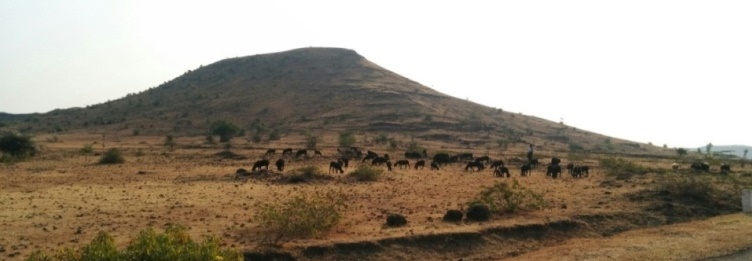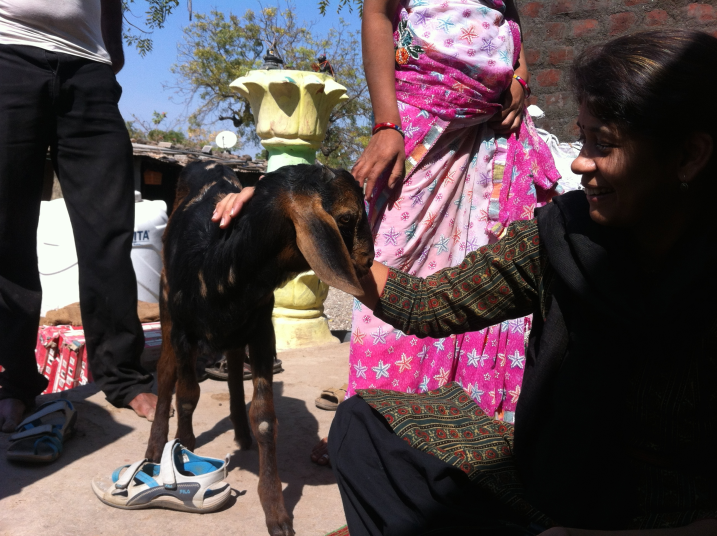Adaptation to climate change: What has social structure got to do with it?

by Divya Nazareth with inputs from Bhavana Rao & Ramkumar Bendapudi
While some may doubt and even deny the existence of climate change, rural households in three villages of Aurangabad District in Maharashtra State, India will tell you it is a reality and a daily battle. Climate change also doesn't act alone - it has two other accomplices – non-climatic risks and coping strategies. In India these accomplices are shaped by historic and structural factors such as caste, gender, local politics and so on, which determine adaptation or maladaptation. In this blog we look at what different caste groups are doing in response to climate change and what has driven them to adopt these practices.

Anjali Whage and Divya Nazareth facilitating a discussion with women with on how they perceive climate change
In early 2016, as a part of ASSAR research, we visited three villages located in the Aurangabad District of Maharashtra to understand how communities are affected by and responding to climate change. We used the Community Driven Vulnerability Evaluation – Programme Designer tool (CoDriVE-PD) to conduct the assessment. As the name suggests the tool aims to undertake a vulnerability assessment by engaging with communities to identify locale-specific climatic and non-climatic risks and how the interface between the two (amid a larger socio-economic context) enhances or constrains adaptation.

Discussions with farmers in Kachner Tanda
All three study villages are located on the upper catchments of the Godavari River. Wanjwarwadi is home to the Rajputs, an upper caste community, located close to the hustle and bustle of major markets in the Paithan block. Kachner and its tandas (hamlets) are inhabited by the Banjara community who were historically nomadic livestock herders, but settled in the village 30 years ago to become sedentary agriculturalists. The majority of the Rajputs are medium farmers (own 4-10 hectares) while the Banjara are largely small (1-2 hectares) and marginal (> 1 hectare) farmers.
The landscape on the way to these villages is characterised by a sea of cotton fields, often punctuated with small tracts of rain-fed crops and fallow lands. These provide plenty of hints into the possible climate risks being experienced in the region.
Discussions began with community members recalling life in the village 20 years ago. An atmosphere initially charged with eagerness to share their experiences was soon replaced by one of loss. The stark contrast between life in the past and life in the present justified this change. A similar narrative emerged across all three villages - that diverse and less water-intensive food crops were cultivated in the past. These crops secured food requirements of the household and fodder requirements of livestock. Agriculture, dairy and small ruminant farming were the main livelihoods of the farmers while landless households worked as agricultural labourers.
From the year 2008 onwards communities began observing climate-related risks such as:
- reduced precipitation
- delayed monsoons
- erratic seasonal rainfall
- unseasonal rainfall
- prolonged summer temperatures
- warmer winters

Prolonged drought has resulted in decreased vegetative cover in the commons
As the discussions progressed it was clear that apart from climate risks, aspirations and unsustainable agricultural practices by communities have also significantly contributed to their vulnerability. Some examples include:
- The division of land within the family has forced Rajput farmers to increase crop density per acre; this combined with erratic rainfall has resulted in an increase in pest attacks due to higher humidity levels.
- The shift towards intensive cotton cultivation has reduced the availability of crop residue for fodder compelling farmers to reduce their cattle herds. This has also led to a shortage in organic manure forcing them to depend on chemical-based fertilisers.
- Climate variability has already had an unfavourable impact on soil health and crop productivity and the current crop production practices aggravate this problem further.
The landless households have migrated in search of wage work while farmers continue to invest and depend on agriculture amid declining productivity as the sentiment “they are farmers, always have been and will continue to be so” is strongly engrained in the community.
Rajput farmers, aided by access to institutional credit, have chosen to invest heavily in agriculture and have abandoned allied livelihoods. Farmers have decided to focus on growing cotton in the hope of recovering the investments made, whereas marginal and small farmers rely on farm and off-farm wage labour during the dry season.
In Kachner Tanda, a village inhabited by the Banjaras, community members were able to trace the climate risks (intensity and frequency) over the past 10 years and spoke in-depth of the impacts. Their historical attachment to livestock has meant that the Banjaras have chosen to sustain their agriculture and livestock systems in a complementary way - something other communities have abandoned. In order to sustain this livelihood mix in the present situation, they have been forced to adapt. They now raise fewer animals and have made major changes to the composition of their livestock holdings.


While exotic breeds are not encouraged in terms of sustainability, engaging with the communities brought in several insights on how they are constantly thinking of new strategies, including potentially maladaptive practices.
In response to declining livelihood opportunities, an unforgiving climate and uncertainty over future, communities in this region are doing their best to adapt. While there is extensive literature on the impacts of climate change on natural resources and livelihoods in semi-arid areas, it is crucial to understand how experiences of climate change are shaped by structural factors and enhance vulnerability. Our discussions revealed how response/coping strategies differed across the social groups. Rajputs in Wanjarwadi have been able to use their high levels of resource endowments and social networks to access credit, allowing them to adopt potentially remunerative but risky strategies. In Kachner on the other hand, the Banjara have innovatively adapted to the risks they face using their traditional knowledge on crop and livestock management. This study reinforced the need for such assessments at a micro level - especially while designing project interventions - as the lack of these assessments could risk unintended and unwelcome consequences.